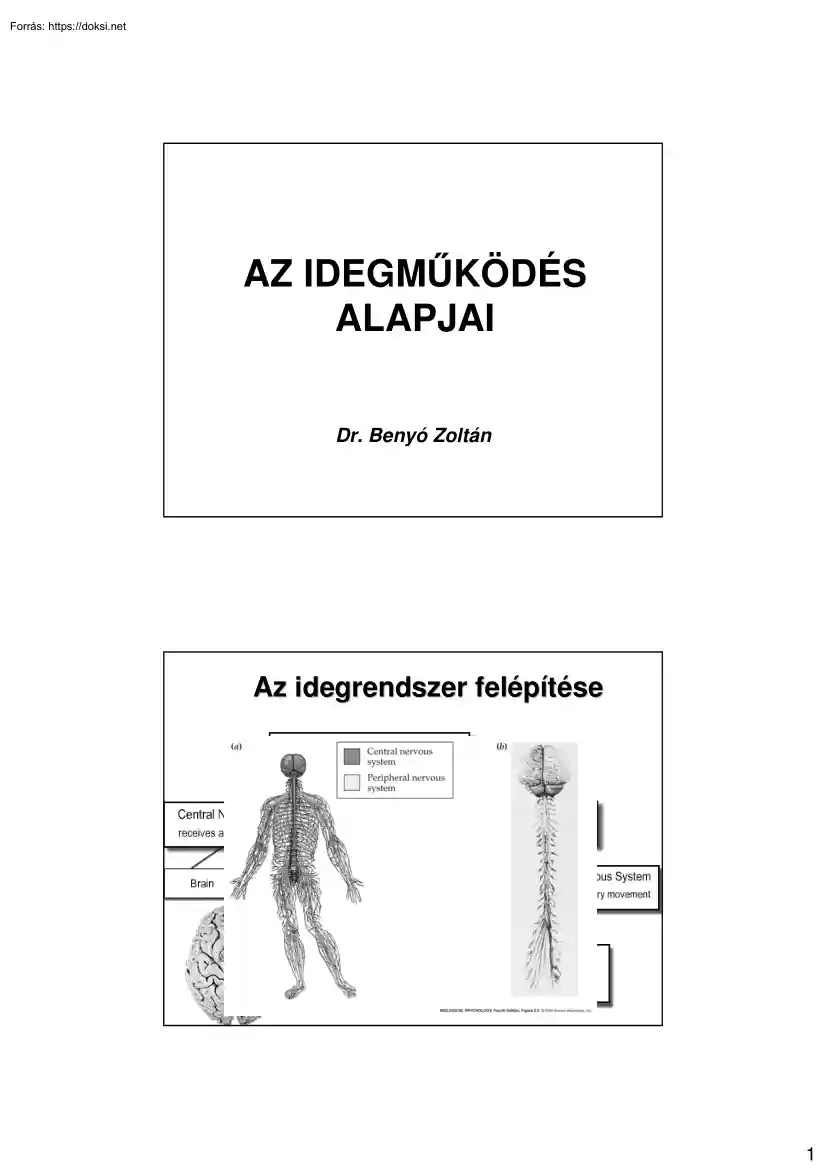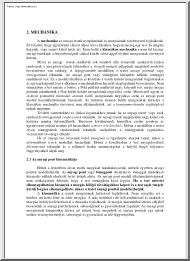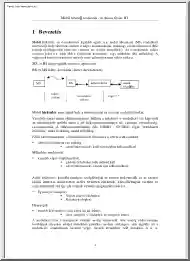A doksi online olvasásához kérlek jelentkezz be!

A doksi online olvasásához kérlek jelentkezz be!
Nincs még értékelés. Legyél Te az első!
Mit olvastak a többiek, ha ezzel végeztek?
Tartalmi kivonat
AZ IDEGMŐKÖDÉS ALAPJAI Dr. Benyó Zoltán Az idegrendszer felépítése 1 Az idegrendszer mőködési sémája FIZIOLÓGIAI INFORMÁCIÓS ÉS KONTROLLRENDSZER KÖZPONTI „PROCESSZOR”EGYSÉG Belsı és külsı környezet Bemeneti egységek (receptorok) Központi idegrendszer Endokrinrendszer Információ„fogyasztók” (szövetek) Az idegrendszer funkcionális felépítése Pszichomotoros válaszok 2 A neuronok funkcionális osztályozása – Szenzoros (afferens) – Motoros (efferens) • Szomatomotoros • Viszceromotoros – Interneuron (asszociációs) Reflexív 3 Az ingerek felvé felvétele, feldolgozá feldolgozása, tová továbbí bbítása és tová továbbadá bbadása a kü különbö nbözı típusú pusú neuronokban Az idegsejtek felépítése: dendritek, sejttest, axon (idegrost) Dendrites – receive the “message” in the form of neurotransmitter (or electric stimulus) across the synapse Terminal arborization – delivers the
“message” as a release of neurotransmitter into the synapse Axon – the message or “action potential” travels along the axon Cell body – contains the materials necessary to keep the cell alive and synthesize neurotransmitter 4 Az információ-áramlás iránya AxonAxonkollaterá kollaterálisok Axondomb Idegrostok morfológiai és fiziológiai osztályozása 5 Szinaptikus transzmisszió Szinapszis Egy neuron és egy má másik neuron vagy effektor sejt kö közötti morfoló morfológiai és funkcioná funkcionális kapcsolat az informá információ ció-átadá tadás cé céljá ljából Preszinaptikus neuron Postszinaptikus neuron Szinaptikus rés 6 7 A szinapszisok anatómiai fajtái Anatomical Types of Synapses Axodendritic – synapse between the axon of one neuron and the dendrite of another Axosomatic – synapse between the axon of one neuron and the soma of another Other types: Axoaxonic (axon to axon) Dendrodendritic (dendrite to dendrite)
Dendrosomatic (dendrites to soma) A szinapszisok osztályozása a jelátvitel formája szerint szerint • Elektromos • Kémiai 8 Az elektromos szinapszis mőködése Property Electrical Synapse Chemical Synapse 3.5 nm 20-40 nm Cytoplasmic continuity? Yes No Structural Unit(s) Gap-junction channel Many (vesicles, docking/fusion proteins, and postsynaptic receptors) Transmitter Ionic current Chemical transmitter (can be modified using drugs) Transmission Delay No Yes (usually 1-5 msec) Transmission Direction Can be bidirectional Unidirectional Distance between Membranes 9 Jelátvitel a szinaptikus résen keresztül a kémiai szinapszisban Property Electrical Synapse Chemical Synapse 3.5 nm 20-40 nm Cytoplasmic continuity? Yes No Structural Unit(s) Gap-junction channel Many (vesicles, docking/fusion proteins, and postsynaptic receptors) Transmitter Ionic current Chemical transmitter (can be modified using drugs) Transmission Delay No
Yes (usually 1-5 msec) Transmission Direction Can be bidirectional Unidirectional Distance between Membranes 10 Neurotranszmitterek jellemzıi Criteria to define a neurotransmitter • synthesized in the presynaptic neuron • present in the presynaptic terminal • released from presynaptic terminal in a calcium-dependent manner • specific postsynaptic receptors for the substance must be present on the postsynaptic cell • termination mechanism exists Neurotranszmitterek osztályozása Categories of neurotransmitters • small-molecule neurotransmitters – produced in the synaptic terminal (e.g glutamate, GABA, ACh, 5-HT) • neuropeptides – large molecules composed of several (3-36) amino acids combined together produced in the cell body (+ axonal transport) (e.g Substance P, endorphins) 11 Neurotranszmitter-felszabadulás Neurotransmitter release Undocked synaptic vesicle Docked synaptic vesicle Cluster of protein molecules in membrane of synaptic vesicle
Cluster of protein in presynaptic membrane Entry of calcium opens fusion pore Docked synaptic vesicle Fusion pore widens, membrane vesicle fuses with presynaptic membrane Molecules of neurotransmitter begin to leave terminal button “Omega” figures Presynaptic membrane Posztszinaptikus receptorok fajtái 12 Ionotropic receptors Molecule of neurotransmitter attached to binding site Binding site of receptor Ions Closed ion channel Open ion channel Metabotropic receptors 1 Molecule of transmitter substance binds with receptor Receptor 2 Receptor activates G protein enter cell, 4 Ions produce G protein 3 postsynaptic potential Alpha subunit breaks away, binds with ion channel and open it 13 Metabotropic receptors 5 of transmitter 1 Molecule substance binds with receptor G protein 4 Ion channel Ions enter cell, produce postsynaptic potential opens 2 Receptor activates G protein subunit 3 Alpha breaks away, activates enzyme, which produces second
messenger nucleus 6 To or other parts of cell Posztszinaptikus (elektrotónusos) potenciálok Postsynaptic (graded) potentials • • • • • Short-lived, local changes in membrane potential (either depolarizations or hyperpolarizations) Decrease in magnitude with distance Sufficiently strong graded potentials can initiate action potentials Changes in membrane potential depend on – The amount of neurotransmitter released – The amount of time the neurotransmitter is bound to receptors Either excitatory (EPSP) or inhibitory (IPSP) – Opening Na+ ion channels results in an EPSP – Opening K+ ion channels results in an IPSP – Opening Cl- ion channels results in an IPSP • Depends on value of membrane potential 14 IPSP EPSP EPSP IPSP Effect Excitation Inhibition (or blockade of excitation) Change in potential Depolarization Hyperpolarization (or inhibition of depolarization) Mechanism Opening of Na channels Opening of K or Cl channels Example(s)
Nicotinic Ach receptor, NMDA receptor GABA-A, GABA-B receptor, Glycine receptor Summation Yes Yes 15 Elemi integráció a szinapszisokban Idıbeli szummáció Successive activation of the same neuron at short intervals brings to summation the excitation (EPSPs) in the target cell 16 Térbeli szummáció When several neurons simultaneously excite the target cell from across the cell body, the excitation builds up and summates at the axon hillock Preszinaptikus gátlás/serkentés Presynaptic Modulation • Modifying PSP by influencing presynaptic neuron • Presynaptic inhibition ↓ amount of NT released • Presynaptic facilitation ↑ amount of NT released • Effect on activity of postsynaptic neuron – depends on nature of synapse 17 A preszinaptikus gátlás A facilitáció jelensége Amikor egy idegsejten EPSPk szummá szummálódnak, dnak, amelyek nem elegendı elegendıek egy AP kivá kiváltá ltására, de megkö megkönnyí nnyítik a kö
következı vetkezı EPSPk szá számára az AP kivá kiváltá ltását („ („facilitá facilitált neuron” neuron”). 18 A neurotranszmitterek „sorsa” sorsa”: diffú diffúzió zió, visszavé visszavétel, degradá degradáció ció 19 20
“message” as a release of neurotransmitter into the synapse Axon – the message or “action potential” travels along the axon Cell body – contains the materials necessary to keep the cell alive and synthesize neurotransmitter 4 Az információ-áramlás iránya AxonAxonkollaterá kollaterálisok Axondomb Idegrostok morfológiai és fiziológiai osztályozása 5 Szinaptikus transzmisszió Szinapszis Egy neuron és egy má másik neuron vagy effektor sejt kö közötti morfoló morfológiai és funkcioná funkcionális kapcsolat az informá információ ció-átadá tadás cé céljá ljából Preszinaptikus neuron Postszinaptikus neuron Szinaptikus rés 6 7 A szinapszisok anatómiai fajtái Anatomical Types of Synapses Axodendritic – synapse between the axon of one neuron and the dendrite of another Axosomatic – synapse between the axon of one neuron and the soma of another Other types: Axoaxonic (axon to axon) Dendrodendritic (dendrite to dendrite)
Dendrosomatic (dendrites to soma) A szinapszisok osztályozása a jelátvitel formája szerint szerint • Elektromos • Kémiai 8 Az elektromos szinapszis mőködése Property Electrical Synapse Chemical Synapse 3.5 nm 20-40 nm Cytoplasmic continuity? Yes No Structural Unit(s) Gap-junction channel Many (vesicles, docking/fusion proteins, and postsynaptic receptors) Transmitter Ionic current Chemical transmitter (can be modified using drugs) Transmission Delay No Yes (usually 1-5 msec) Transmission Direction Can be bidirectional Unidirectional Distance between Membranes 9 Jelátvitel a szinaptikus résen keresztül a kémiai szinapszisban Property Electrical Synapse Chemical Synapse 3.5 nm 20-40 nm Cytoplasmic continuity? Yes No Structural Unit(s) Gap-junction channel Many (vesicles, docking/fusion proteins, and postsynaptic receptors) Transmitter Ionic current Chemical transmitter (can be modified using drugs) Transmission Delay No
Yes (usually 1-5 msec) Transmission Direction Can be bidirectional Unidirectional Distance between Membranes 10 Neurotranszmitterek jellemzıi Criteria to define a neurotransmitter • synthesized in the presynaptic neuron • present in the presynaptic terminal • released from presynaptic terminal in a calcium-dependent manner • specific postsynaptic receptors for the substance must be present on the postsynaptic cell • termination mechanism exists Neurotranszmitterek osztályozása Categories of neurotransmitters • small-molecule neurotransmitters – produced in the synaptic terminal (e.g glutamate, GABA, ACh, 5-HT) • neuropeptides – large molecules composed of several (3-36) amino acids combined together produced in the cell body (+ axonal transport) (e.g Substance P, endorphins) 11 Neurotranszmitter-felszabadulás Neurotransmitter release Undocked synaptic vesicle Docked synaptic vesicle Cluster of protein molecules in membrane of synaptic vesicle
Cluster of protein in presynaptic membrane Entry of calcium opens fusion pore Docked synaptic vesicle Fusion pore widens, membrane vesicle fuses with presynaptic membrane Molecules of neurotransmitter begin to leave terminal button “Omega” figures Presynaptic membrane Posztszinaptikus receptorok fajtái 12 Ionotropic receptors Molecule of neurotransmitter attached to binding site Binding site of receptor Ions Closed ion channel Open ion channel Metabotropic receptors 1 Molecule of transmitter substance binds with receptor Receptor 2 Receptor activates G protein enter cell, 4 Ions produce G protein 3 postsynaptic potential Alpha subunit breaks away, binds with ion channel and open it 13 Metabotropic receptors 5 of transmitter 1 Molecule substance binds with receptor G protein 4 Ion channel Ions enter cell, produce postsynaptic potential opens 2 Receptor activates G protein subunit 3 Alpha breaks away, activates enzyme, which produces second
messenger nucleus 6 To or other parts of cell Posztszinaptikus (elektrotónusos) potenciálok Postsynaptic (graded) potentials • • • • • Short-lived, local changes in membrane potential (either depolarizations or hyperpolarizations) Decrease in magnitude with distance Sufficiently strong graded potentials can initiate action potentials Changes in membrane potential depend on – The amount of neurotransmitter released – The amount of time the neurotransmitter is bound to receptors Either excitatory (EPSP) or inhibitory (IPSP) – Opening Na+ ion channels results in an EPSP – Opening K+ ion channels results in an IPSP – Opening Cl- ion channels results in an IPSP • Depends on value of membrane potential 14 IPSP EPSP EPSP IPSP Effect Excitation Inhibition (or blockade of excitation) Change in potential Depolarization Hyperpolarization (or inhibition of depolarization) Mechanism Opening of Na channels Opening of K or Cl channels Example(s)
Nicotinic Ach receptor, NMDA receptor GABA-A, GABA-B receptor, Glycine receptor Summation Yes Yes 15 Elemi integráció a szinapszisokban Idıbeli szummáció Successive activation of the same neuron at short intervals brings to summation the excitation (EPSPs) in the target cell 16 Térbeli szummáció When several neurons simultaneously excite the target cell from across the cell body, the excitation builds up and summates at the axon hillock Preszinaptikus gátlás/serkentés Presynaptic Modulation • Modifying PSP by influencing presynaptic neuron • Presynaptic inhibition ↓ amount of NT released • Presynaptic facilitation ↑ amount of NT released • Effect on activity of postsynaptic neuron – depends on nature of synapse 17 A preszinaptikus gátlás A facilitáció jelensége Amikor egy idegsejten EPSPk szummá szummálódnak, dnak, amelyek nem elegendı elegendıek egy AP kivá kiváltá ltására, de megkö megkönnyí nnyítik a kö
következı vetkezı EPSPk szá számára az AP kivá kiváltá ltását („ („facilitá facilitált neuron” neuron”). 18 A neurotranszmitterek „sorsa” sorsa”: diffú diffúzió zió, visszavé visszavétel, degradá degradáció ció 19 20



